
Newsletter of the Shell Club of Sydney
NSW Branch, The Malacological Society of Australasia Limited ACN 067 894 848
Treasurer's Annual Report
TO 30 JUNE 2002
Shell Club of Sydney, NSW Branch, The Malacological Society of Australasia Limited ACN 067 894 848
John Franklin, Treasurer N.S.W. Branch
The financial activities of the Shell Club over the past twelve months showed an outstanding credit result, probably the best on record, in a year where no national shell show was conducted.
After taking into account the proceeds from the auction conducted at the June meeting, the Club ended up with a credit balance of $2,013.13.
Apart from the wonderful assistance given by those conducting the raffles, our thanks must also go to those who generously donated the prizes. In addition, the Shell Show last year was sponsored by gifts to the Club from Mrs. B. Collins, Mr. D. Tarrant, Mr. N. Coleman and the Leagues Club in providing a dinner for two to the value of $80.00.
Membership:
- The year ended with 29 financial members of the Shell Club and 2 Life members.
- As at the 9th May 2002, 8 members of the Shell Club were also financial members of the N.S.W. Branch of
M.S.A.
- The Branch received a cheque during the year for $318.00 from M.S.A. being the rebate for 2001 membership subscriptions at $15 per active member and $6 for the remaining subscriptions from
N.S.W."
- As at the 9th May 2002 there were 16 financial members of M.S.A. resident in N.S.W. who have not formally applied for N.S.W. Branch memberships and do not attend N.S.W. Branch meetings.
I wish to thank our President, Dr. P. Jansen, the Committee and those who regularly attend meetings for the assistance given to me as your Treasurer over the last 12 months.
Turbinellidae Part 20
Ulrich Knodel
In this paper, after finishing the second sub family Vasinae, I have to return to the first sub family Turbinellinae.
Recent systematical changes have transferred the genus Syrinx from the Melongenidae Gill, 1871 to the Turbinellidae with a place close to
Turbinella sensu lato.
Turbinellinae, genus Syrinx Röding 1798
Syn: Megalatractus Fischer 1884
One recent species
Syrinx aruanus (Linne 1758)
Syn Syrinx proboscidiferum Lamarck
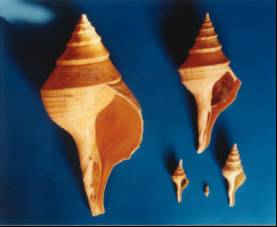
This is the only recent species of the genus and the worlds' largest gastropod. The scientific name is based on an error; the first known shells were thought to be from the Aru Islands, Indonesia (aruanus = from Aru). The common name is "Australian Trumpet" or "Reef Trumpet" due to its use as trumpets in the past; another use was as a water pot.
The known range is the southern coast of New Guinea and northern Australia from Bunbury (WA) to southern Queensland. The species is common but larger specimens are hard to find today, due to overfishing. It lives on intertidal flats with mud or fine sand to a depth of approximately 60 metres where it feeds on clams and snails.
The size of adults is 300mm to 800mm but shells larger than 450mm are rarely found these days. The shell is fusiform with a long anterior canal and surely known to every shell collector. The juveniles when leaving the cup shaped egg capsules which are fastened in rows on rocks, develop a distinct long thick apex as large or larger than the smooth body whorl. Later, when the body whorl is more developed, the apex is shaped as a long spire of eight whorls of the same size; the shell is strongly corded, with rounded knobs well present.
Adults decollate the apex and the shell looks rather smooth: regular cords are visible but the knobs are very weak or absent. The yellowish shell is hidden under a thick grey brown periostracum. Shells bought from dealers have usually been cleaned with the periostracum removed.
Two forms are reported. The northern shells have a high shouldered spire and the shoulder is carinated. Southern shells, from the Bunbury region, have the shoulders rounded and the spire not so high erected.
Left: Typical adult (390 mm) from Bunbury, WA. The right shoulder is rounded, the spire not so high erected.
Above Right: Adult (290mm) from northern Queensland with higher erected spire and the shoulder carinated.
Below Right: a juvenile (123 mm) from Queensland with high spire partly broken off (transport).
Below Left: a juvenile (89mm) from Queensland with high spire intact.
Below Centre: a very juvenile (19mm) from Bunbury. The thick spire makes 2/3 of the shells' length; the still smooth body whorl is only 1/3 of the length.
Shell Club Minutes
27/04/2002
Meeting opened by Patty Jansen at 2.08 pm.
Field Trip Reports.
Steve Dean had a trip to Coffs Harbour and Sawtell. He found keyhole limpets and endemic north coast shells including
Mipus arbutum Woolacott, 1954 and David Tarrant gave him an
array of colourful beetles, which had been washed up as a result of the bushfires.
Patty reported that The Good Friday field trip was attended by herself only.
On the 25th of April, Patty and family met up with Chris Barnes at Little Bay, where Chris found a
Cypraea helvola Linnaeus, 1758.
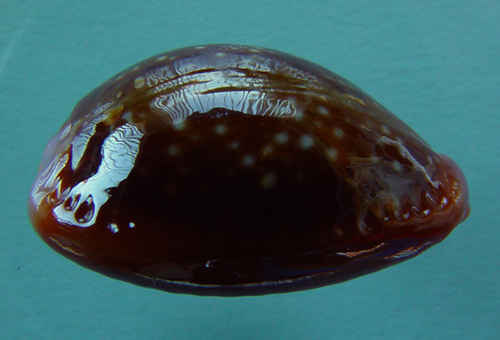
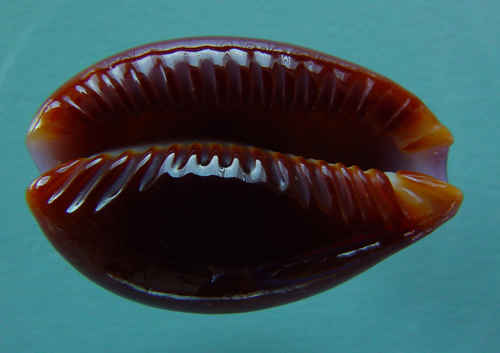
Chris also found a Cypraea lynx Linnaeus, 1758 on a subsequent trip. Both cowries
were drilled by octopus. Another find by Chris at Little Bay was Gyrineum lacunatum (Mighels, 1845) which was sitting on what is
believed to be a clutch of eggs. A digital image will be printed next "Sheller".
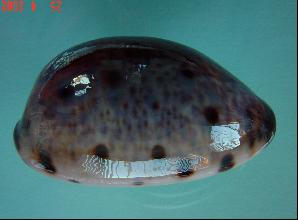
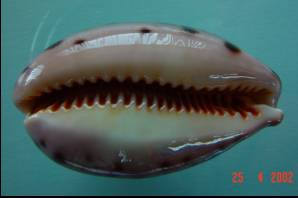
General Business
Mike Korty from South Africa is reported to be moving to Sydney.
Presentation
Patty Jansen gave a presentation on Worldwide Limpets.
Patty described the family and sub genera with descriptions, two
demonstration trays of shells and known distributions.
Meeting closed at 2.45 pm
C & K. Barnes
Secretary.
More Aquatic Reserves in Sydney Area
By John Franklin
Some time ago six Sydney Central Coast intertidal shores became temporary Intertidal Protected Areas (IPAs). On the 31st March 2000 pursuant to the Fisheries Management Act 1994 those six areas became Aquatic Reserves. The areas are; the base of Barrenjoey Headland, Cape Banks (La Perouse), Cabbage Tree Bay next to Shelly Beach Manly, Bronte to Coogee, Narrabeen Point and Boat Harbour (Cronulla). The collection of invertebrates is prohibited in all new aquatic reserves but researchers and collectors should make further enquiries from the Dept. of Fisheries Coffs Harbour NSW regarding the issue of permits.
Shell Club Minutes
23/02/2002
Meeting opened Patty Jansen 2.03 pm.
Visitors: Brian Bailey, Solomon Islands
New Member: Sandra Montague
Field Trip Reports
Ashley Miskelly passed around specimens he found at Vaucluse.
Ron Moylan displayed a Zoila rosselli edengeri light in colour valued at $3500.00.
John Dunkerley found a Conus textile and many variations of Cypraea from Coolum on the Sunshine Coast. He has visited this area 3 years running but this time there were more shells.
Patty Jansen spent two weeks in New Zealand and went to the Wellington Shell Show. She reported that the weather was bad howling winds and temps of only
13 degC but the show was well attended and a nice social event, nevertheless. Rotorua was warmer, at
25 degC, where she enjoyed a holiday with the family.
General Business
P. Jansen organised a cake roster for upcoming meetings.
A field trip has been planned for Good Friday, 29th March at Little Bay.
The meeting agreed to offer an expression of interest in bidding for the 2006 National Shell Show. Patty to deal with arrangements.
Raffle prizes: One shell per month will be donated as a raffle prize from the Collection of Gertie
Thornley.
John Franklin will contact Cheryl Sutton re booking an upstairs room for the annual shell show in October.
Presentation
Ron Moylan gave a video presentation on trips to the Swanes Reef and various Capricorn / Bunker Group islands.
C. & K. Barnes, Secretary
Unitas Malacologcia
By John Franklin
World Congress of Malacology Perth, Western Australia 11-16 July 2004
We have been notified that the next World Congress of Malacology will be held in Perth, Western Australia, the first such Congress in the Southern Hemisphere. It will be held on the campus of The University of Western Australia, from 11 to 16 July 2004.
It is the 15th International Congress of UNITAS MALACOLOGICA and is being jointly organised by Unitas and the Malacological Society of Australasia.
Several major symposia are planned:
- Phylogeny of molluscs;
- Molluscan aquaculture and fisheries;
- Ecology of molluscs;
- Special sessions on particular groups (such as bivalves) and other topics (e.g. conservation) are also planned or can be included.
There will also be contributed paper sessions and a choice of four excursions.
CONFERENCE ORGANISER: Dr. Fred Wells, Western Australian Museum -
wellsf@museum.wa.gov.au
Shell Club Minutes
25/5/2002
Meeting opened Patty Jansen 2.10 pm.
Field Trip Reports.
Ron Moylan had a successful trip to the Barrier Reef, 220 km off Gladstone, to dive and dredge. Shells found included
Voluta excelsior, Voluta coucimorum (of the Pulchra Complex) and an unusual form of
Cymbiola pulchra forma peristicta ( McMichael, 1963). Ron made the trip pay by collecting cones for a pharmaceutical company in Brisbane that is researching the medical usefulness of the conotoxin. Interestingly, some of the cones which ate each other were not the usual carnivorous ones. One of the cowrie shells climbed the sides of the tank and dropped off to avoid being harpooned.
John Franklin found a juvenile Cypraea tigris Linnaeus, 1758 in a rock pool at Sawtell, 6 km south of Coffs Harbour.
Chris Barnes found four live Meridolum sp (middenensis?) at South Maroubra during a storm (as requested). They were fed grated carrot and tissue, then handed over to Stephanie for her research.
General Business
M. Keats is to turn over branch term deposit.
A. Browne to investigate Whitlam Centre as possible venue for national shell show, when next held in Sydney.
Letter, from Collectors Corner re- parties interested in supplying marine specimens.
M. Keats reminded everyone that next meeting's presentation was to be an auction and to bring along any shells or shell memorabilia. The auction will make money for the club from the donated items and 10% of sales.
Afternoon tea followed by presentation.
Presentation
Jack Hannon gave the presentation on weather patterns and their impact on shell collecting.
Jack recommended that collectors be aware of weather conditions from a safety aspect so that they are not surprised by squalls and storms. The meeting looked at weather maps and isobar readings so as to recognise troughs and low pressure systems.
Jack answered questions from the group and I believe everyone enjoyed the talk.
C. & K. Barnes, Secretary
Shell Club Minutes
22/6/2002
The meeting was opened at 2.30pm by the president.
Present:
Stephanie Clark, Des Beechey, Noel & Maureen Anderson, Ashley Miskelly, John Dunkerly, Adrian Browne, Steve & Keith Dean, Patty Jansen, Sandra Montague, John Franklin, Jack Hannan
Apologies:
Chris Barnes, Frank McCamley, Katherine Kindt
Collecting trips:
Ashley went diving in Sydney Harbour and found the hammer oyster Malleus albus. He also found a large tun shell with a dead Turbo exquisitus inside, as well as Acrosterigma reeveanum, Pinna bicolor (dead), and Fusus brazieri at a depth of about 18m.
Steve went to Mona Vale and found a very nice Cypraea felina, the rare bubble shell Aplustrum aplustre, a very colourful Alocospira oblongata (Olivellidae) and Cypraea asellus.
Des Beechey reported on his dredging efforts at Fraser Island and Hervey Bay, where his boat is now moored. During the ten days of his visit, bad weather prevented much collecting for six days. On the remaining days, they trawled at a few places, but found little of interest, except lots of black mud and very dead shells.
General Business:
Michael Keats distributed copies of 'Waves' Our monthly activity was an auction, conducted by Michael Keats, with Noel Anderson as recorder, with material donated by or sold on commission for
members. There was a wide range of material, including some rare shells, but also books, ornamental items, sea urchins, shell artefacts, storage boxes and tubes and even a mammoth tusk! Almost everyone present obtained something of their liking.
Minutes of the AGM of the NSW Branch of the MSA
The meeting was opened at 2pm by the president.
Present:
Stephanie Clark, Des Beechey, Noel & Maureen Anderson, Ashley Miskelly, John Dunkerly, Adrian Browne, Steve & Keith Dean, Patty Jansen, Sandra Montague, John Franklin, Jack Hannan
Apologies: Chris Barnes, Frank McCamley, Katherine Kindt
All officebearers were re-elected unanimously (moved Peter Pienaar, seconded Ron Moylan)
The president's report was tabled and accepted and will be published in the June Sheller
The treasurer's report was tabled and the treasurer gave a brief explanation. The branch has a bank balance of $815, an improvement of about $500 compared to last year. This is mainly due to increased income
from the raffle. Thanks are due to Maureen Anderson. The Branch's term deposit has been re-invested. The total amount now stands at $5112.45, with interest payment for this year $217.43
It was decided that a committee be formed to prepare a bid for the National Shell Show in 2006. Steve Dean, Adrian Browne, John Franklin and Patty Jansen volunteered for this. However, all present agreed that if successful, the committee will call on all available club members to assist.
A provisional programme for the coming year was determined:
The meeting was closed at 2.30pm
Turbinellidae Part 19
Ulrich Knodel
Before we can close the chapter on Vasinae, there are still three species to report on. They are obviously rare and poorly known. I do not have any in my collection and was only able to get very basic information about them. If anyone has further information, I would be thankful for photos and photocopies of any literature for my future studies.
Vasum armatum (Broderip 1833)
As Turbinella armata Broderip 1833
Syn Vasum ceramicum var armata Broderip Gould, 1933
The only known source of the "Armed Vase" is Eastern Polynesia. The Tuamoto Islands, Phoenix Islands and Eastern Samoa are the reported localities, with Elizabeth Island (Tuamotus) as type locality.
The habitat is "..in pockets of sand on the reef flats facing the open ocean in the intertidal zone" (Abbott, 1959). It is reported to be moderately common to abundant (at least in 1959) but I have neither one in my collection nor have I seen it offered in a dealers list.
The solid shell is somewhat fusiform, the spire elevated. Two rows of equallly sized spines appear at the shoulder and the grey - white colour of the outer shell with its bluish brown mottlings in a band, give this species a distinct appearance but in fact it looks similar to
Vasum ceramicum.
It is said to have been developed from the line of V. aquitanicum of the lower Miocene, closely related to
V. turbinellus, tubiferum, rhinoceros and ceramicum. A photo appears in Abbott's "Compendium of Seashells". The size is approximately 50mm but shells sized 46-74mm have been reported.
Vasum crosseanum Sowerby 1892
The "Crosses Vase" is described poorly even in Abbott, 1959. As a summary it is a rare offshore species from waters off the Seychelles and Madagascar, with a length of approximately 90mm. It looks somewhat like a "spineless Tudicula armigera" and could be misplaced here in the (sub-) genus Vasum (Vasum). A photo of this is also to be found in the "Compendium of Seashells".
Vasum lactisfloris Ferrario 1983
Until now I have neither seen the original description (which was even republished with further information two years later) nor other remarkable papers. The species is said to be closely related to
V. stephanti (see part 15< Oct 1999) and could fall within the variation range of the latter with which it lives, sympatric off Somalia, East Africa.
|





